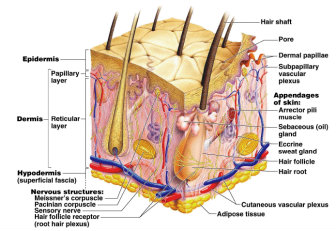Stop Using Pesticides to Kill Fleas
Poisoning Fleas, Pets, and Kids
Stop Killing Your Pet: The Top 5 Ways – Part 3

Okay, I hope you’re ready, Spot. I’ve got a tube of pesticides here for you. Let me just drop this on your shoulders.
Fleas: take this and DIE!
If you knew something was poison, you’d want to keep it away from your pet, right?
Wanting to protect your loved ones is natural, but countless dogs and cats get poisoned on a regular basis, all in the name of “flea control.”
Score: Clever Marketing 1, Pets 0.
Most flea control products are pesticides. Pesticides are poisons. Period. Pesticides put your pet at risk.
You have natural flea control options, so please
Stop.
Using.
Poisons.
The best flea treatments are the ones that kill fleas without making your animals (or your family) sick.
Cancer and More
It’s been known for decades that exposure to pesticides increases the risk of cancer. An early study showed dogs getting malignant lymphoma in far higher incidence than expected when their owners used lawn pesticides.
Fipronil, the active ingredient in a popular topical flea product (Frontline) has been associated with aggressive behavior, kidney damage, and “drastic alterations in thyroid function.” The EPA cites data to show it causes cancer. It’s extremely toxic to fish, birds, and bees.
How These Products Cannot Be Safe
Labels tell a lot, but you have to read the fine print to keep your animal out of harm’s way. You’ll see warnings accompanying all pesticides, if you look for them.
In the case of the most popular products, the “topical tubes” like Frontline, Advantage, and their cousins, the warning is largely aimed at you, the user.
From an actual label:
“Keep out of the reach of children.
Children should not come in contact with the application site for 30 minutes after application.
Causes eye irritation. Harmful if swallowed. Do not get in eyes or on clothing. Avoid contact with skin. Wash hands thoroughly with soap and warm water after handling.
If contact with skin or clothing occurs, take off contaminated clothing. Wash skin immediately with plenty of soap and water.”
So, think with me here.
The companies are warning you not to get this in or on your body and especially your child’s body, but it’s somehow just fine to put on your pet’s skin?
Umm, where’s the logic, there, exactly?
The claim is that these topical flea control poisons somehow magically don’t get absorbed. They supposedly stay only in the sebum, the fat layer of the outer skin, and don’t get inside your animal.
But wait.
Skin is not lifeless, right? It’s not like some impervious shell we and our pets live in. It’s a living, breathing organ, supplied with blood capillaries, and full of pores.
[You remember pores, don’t you? Those damned things that filled with sebum or got clogged up in other nasty ways when you went through adolescence? There were a lot of them on your face, remember? Well, they are all over.]
These same pores are points of exchange. Oil or sebum is there to give that shine to hair or skin, sweat issues forth to cool the core when they open, goose bumps rise, hair stands on end when a dog feels threatened — in short, this is an active, living surface!
Safe for my Dog, Not for my Child?
Common sense should tell you to think twice about these pesticides being risky to you and your kids but not your dog or cat.
“These are poisons that we are applying to our pets,” said EPA Assistant Administrator Steve Owens in 2010.
Bigger, Better, Faster: The Story of Resistance
There’s a movie called Sweet Land, about Scandinavian immigrants in Minnesota in the early part of the 20th century. It’s one of the sweetest, most human movies I’ve ever seen, and I highly recommend it.
In the 1920’s, as portrayed here, the land was largely untouched, and farming it was the goal to make a life for one’s family. The draft horse was the farmer’s means to getting the land worked. Plowing, disking, planting, hauling off trees, pulling the thresher, taking the crops to the mill — the horse was indispensable in all this work.
The movie is set right at the beginning of the industrial age, so tractors had just been introduced. Frandsen, one of the main characters, a lovable fool, has one, and is so proud of his new mechanical horse that can do the work of an entire team of six or more draft horses.
“Bigger, better, faster,” he grins, telling his friend’s new bride, who’s just arrived from Norway, in awe at this new country.
Like the pesticides used in farming, against weed or weevil, the problem of resistance develops in the targeted victims. A certain percentage of any living population of pest has a gene or three that confer resistance to the chemical coming at them. It’s the way nature is made.
We’re Alive, Pass It On!
These resistant ones breed with the other resistant survivors, and those genes naturally get selected for. They are passed on to subsequent offspring, who grow increasingly resistant to the poison with each new generation.
This drives the poison makers crazy. They lose money if they can’t kill the pest, and so, they make their poisons “bigger, better, faster.”
Antibiotics are a classic example. When penicillin first appeared, it killed most bacteria and was the miracle drug of its day. Now, several generations of people later, its powers are greatly reduced, and successively more toxic classes of antibiotics have been created.
And people taking these new generations of drugs experience more toxic side effects than plain old penicillin ever brought them.
 The same course happened in weed control and herbicides, and it’s happening as we go down the path of flea poisons.
The same course happened in weed control and herbicides, and it’s happening as we go down the path of flea poisons.
The label for Merial’s latest and greatest claims “The killing action of FRONTLINE TRITAK For Dogs kills fleas fast…”
Unfortunately, “bigger, better, faster” in the pesticide world also means “more toxic.”
The Answer: Natural Flea Control to the Rescue
You don’t want fleas sucking your pet’s blood, causing itching and discomfort, that’s a given.
But poisoning your pet to kill the fleas isn’t much of an option either, is it? The price for that is illness and early death. A bit like torching your house to kill the ants in your cupboards.
There are safe, natural flea control alternatives, and they are still convenient and easy to use, but don’t poison your dog or cat (or your kids!).
In our rush for convenience, we may forget the baby as we toss out the dirty bath water. Far better will be to spend a bit of time understanding the enemy (here, the flea or tick), and choosing your best flea treatment wisely.
My Non-Toxic Flea Control page helps you understand the pest and where your efforts are best spent to control it. Safely. Effectively. Without collateral damage to your loved ones.
The methods I’ve outlined there have worked for generations of pets and their thinking owners.
Natural flea control that works and doesn’t poison your pet. What a concept.
So, grab a cup of your favorite beverage and head over there. Spend some time to understand the life cycle of the flea and where to get the most effect with the least possibility for harm.
And tell us in the comments what’s been working for you.
Ready for Part Four? Click here: Stop Using Poisons for Heartworm Prevention





I’ve heard or read somewhere that poultry seasoning (sage, rosemary and thyme) are an all natural flea treatment for cats! Hope this helps!
DE!!!! Diotamecious Earth !! Fleas love it, eat it up and explode, a lot like what BORAX does too!!!!! Lots of uses in and out of the house.
This is from an Indian homeopath who has a book on how to use homeopathic remedies to rid your garden of pests. I have not tried this yet, but just bought some vials of Ledum Palustre to try when flea season starts again. I just don’t know how to make a tincture of it to rub on my dogs. Anyone?
“Fleas are fleas, right? So the remedy is the same as for fleas on cats – Ledum palustre herbal tincture. Rub it onto you dog’s skin but do it in the garden so the fleas have somewhere else to jump to rather than into your carpet or onto you.” Kaviraj.
I have a older Cat. This is the first year she has gotten fleas. I have bathed her, salted the carpet. She still has fleas. It driving me crazy. What do I do
She does not go out side since this started. HELP.
Her health status has fallen. She’s now attracting parasites, like all weakened animals and even plants do. I’d hire a homeopathic vet, change her to a raw balanced diet, and give her a month or two of flea combing until she bounces back. See my Recommended Resources page for the AVH list, choose a vet who does 75% or more homeopathy, and works by telephone (unless you’re lucky enough to have one near you, of course). And focus on flea control that’s not salt or bathing: http://vitalanimal.com/non-toxic-flea-control/
If you read the fine print on the precautions labels for Nexgard ,for example, it says that the product has not been evaluated on breeding and lactating dogs, and yet veterinarians are giving it to them. They also state use with caution on dogs with history of seizures? What does that tell you.?
I put Frontline on my Buddy – back of the neck – yesterday morning around 10:00. By 10 p.m. he was shaking his head violently, like dogs do when their ears are infected. He was scratching himself, chewing at his feet, and was restless and anxious. I found the horror stories on the Internet and shampooed his neck around 11:00. About an hour later I shampooed his neck again, using Dawn dishwashing liquid. He calmed down and we slept until he started shaking his head violently at 5 a.m. I gave him a benadryl. He calmed down for a while but started shaking his head again around 6:30. He is still anxious and restless. I will call my vet at 8:30 to see if there is an antidote. I don’t know if what she will do will help or harm Buddy. She prescribed Apoquel. After a recent skin flare up , he is now on antibiotics and she gave me a betamethasone spray. We are trying to get his ALK PHOS down from 6,000+ by eliminating steroid Tameril P that my old vet had him on for several months. I found this site and stopped Apoquel yesterday. I should have kept reading, but I had researched Frontline and it seemed the safest topical. I had been using Advantage Multi and wanted to stop the oral flea preventive.
All that to ask this: Is there anything I can do for Buddy to get him through this adverse reaction OTHER THAN take him to Whitecoat and pray she doesn’t harm him? I am very frightened for him, but so far he has not had the seizures that so many have reported. Since 2007. Unbelievable. Insane.
Oh, Dona, what an awful mess poor Buddy is in. This might be a short term fix: get Nux vomica 30C (from who ever sells homeopathic remedies near you), and give him a pellet twice a day for 3 days, then STOP.
Long term, get thee to a vet homeopath so you can cure him. See my Resources page for the AVH list, and look for one of my colleagues who practices in the 75-100% range of homeopathy in his/her practice. Work by phone if no one is close, it’s entirely workable.
Good luck. He needs professional help now, as there’s been a lot of suppression that he’s paying a dear price for. That can’t continue without dire consequences.
Dr. Falconer, thank you for responding! I will look for homeopathic vets and the vomica lux. Is the vomica lux to help him detox from the Frontline or for some other bit of mending?
Unfortunately or fortunately, Sat morning the vet prescribed prednisone, an ear gel, and said to continue the antibiotics, benadryl, and apoquel. So I am bombarding him with whitecoat meds. I was afraid not to. His skin was hot almost everywhere. Inside his ears the skin was the reddest I have ever seen, he would not let me touch them, and he kept shaking his head violently. Inside, they looked horribly sunburned. He kept raising his head and staring around, as if he were seeing something near the ceiling. He has been comfortable since seeing the vet, his skin cooled, and his ears look normal and he lets me touch them now. He eats and drinks and acts normal other than being more quiet than usual. He became a little playful once today, but remains very quiet . I was and am afraid to ignore her instructions and prescriptions, but as soon as Buddy gets detoxed, I will try to find the holistic path for his skin allergies and flea prevention. And getting his ALK PHOS down, which if we can’t, we will test for Cushings. It is down from 6000+ to 847 after omitting steroids, but now he is back on them for 6 days. I know, I’m rattling on. I am just very frightened over what additional harm I am doing to him, what harm I might cause by not doing what I’m doing, and feeling guilty, guilty, guilty and sad.
Im thankful for the post. Great.
I have to say its been a year since I stopped using frontline. My dog would dive into the pool as soon as I put it on her skin. Thats what made me think!! She must know something I don’t.
I thought about the last time I had seen a flea in my area of Florida, couldn’t remember, so why was I using this on my dog in the first place?
Still haven’t seen a flea and my dogs feel better. I will cross the bridge of ridding them of something when they get it.
Sorry just posted and didn’t fill in properly
Yes, Susan, hard to justify poisons anytime, but especially if you’re not seeing fleas! I’ve had really good reports of the Wondercide products helping, especially in the environment. If they return, that might nip them in the bud.
What natural remedy can I use, instead of Revolution, for preventing heart worm? I live on a lake on Galveston Island where there are many, many mosquitos. Are there any holistic vets in Galveston County?
Hi Mona, and welcome!
Your question is timely, and I’d suggest you sign up for email updates on the website (scroll to the top of this page), as the next post in my series, “Stop Killing Your Pet: The Top 5 Ways” is about heartworm. It’ll go out tomorrow. When you sign up for updates, you’ll be the first to get blog posts and other interesting stuff from me.
To find holistic vets near you, visit my Resources page. You’ll see a couple of listings there. One for holistic vets and another for a certain kind of holistic vet, we who are homeopathic vets.
I wish you the best with your animals on Galveson Island.